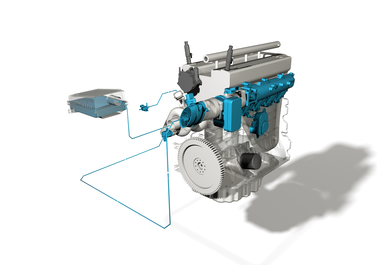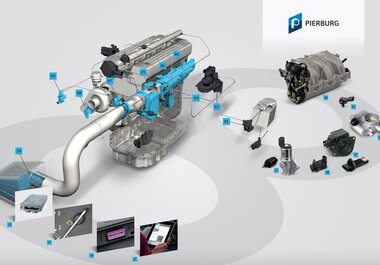
Pressure Transducer
Product Summary
Information on the product
What is the function of the pressure transducer in the exhaust gas recirculation (EGR) system? Why do you need a pressure transducer in a VTG turbocharger? What types of pressure transducers are there? How is it constructed? What malfunctions occur if a pressure transducer is broken? How do you check whether a pressure transducer is damaged? You can find out here.
PRODUCT DESCRIPTION
Pressure transducers are used in large numbers for exhaust gas recirculation systems (EGR) and VTG-superchargers (”Variable Turbo Geometry”, turbochargers with variable vanes). Their function is similar to that of a ”Dimmer” in an electrical circuit: From a vacuum and atmospheric pressure a mixed pressure (control pressure) is formed in the Pressure transducer that can be infinitely varied via the pneumatic actuator (”vacuum cell”).
Via a pressure transducer in conjunction with a pneumatic regulator, far higher forces can be exerted than possible in an electrical system with ”dimmer” and actuator – and this with smaller sizes. The necessary vacuum is present in virtually all vehicles (e.g. from the intake pipe or a vacuum pump).
VARIANTS
The pressure transducers are dimensioned according to the particular application. The following can be varied depending on the requirements (Fig. 1):
- Type of position of electrical connection (connector variants, contacting)
- Position of pipe connections
- Method of attachment (bracket)
- Characteristic
- With / without temperature compensation
- Current or pulse controlled
- Dynamic (evacuation / vent time)
- With / without filter at vent connection (ATM)
APPLICATIONS
Exhaust gas recirculation (EGR)
01 Air filter
02 Pressure transducer
03 Vacuum pump
04 Engine control unit
05 Catalyst
06 EGR valve
07 EGR cooler
Exhaust gas recirculation serves for the reduction of pollutants in the exhaust gas. The fresh air supplied to the engine is added to the exhaust gas. This reduces the oxygen content in the combustion chamber and in turn the combustion temperature. The lower combustion temperature reduces the emission of nitrogen oxides (NOx).
An exhaust gas recirculation system only operates effectively when it is precisely controlled. EGR valves can be controlledeither pneumatically or electrically, depending on the particular type. With pneumatic control, the necessary vacuum (”control pressure”) modulation takes place via a pressure transducer.
The pressure transducer is controlled via a specific family of characteristics. The control pressure with which the EGR valve is operated is set depending on the signal mark-space ratio.
VTG-supercharger
01 Air filter
02 Pressure transducer
03 Vacuum pump
04 Engine control unit
05 Catalyst
06 VTG-supercharger
07 Vacuum cell
08 Variable vanes
09 Charge air cooler
The achievable engine torque of a vehicle with internal combustion engine depends on the proportion of fresh gas in the cylinder charge.
Exhaust gas turbochargers utilise the energy in a turbine in order to increase the cylinder charge via a connected compressor. VTG-superchargers vary the required boost pressure by varying the turbine vanes. This variation must take place with precision.
The pressure transducer is controlled by the engine control unit via a specific family of characteristics. The control pressure withwhich the turbine vanes are varied via a vacuum cell is setdepending on the signal mark-space ratio. This variable turbinegeometry enables a particularly rapid response at low speeds and high efficiency in the upper speed range.
TYPICAL CHARACTERISTICS
| Rated voltage | [V] | 12 |
| Operating voltage | [V] | 10 - 16 |
| Resistance | [Ω] | 11 - 16 |
| Inductivity | [mH] | 40 |
| Pulse duty factor | [%] | 20 ... 95 |
| Frequency | [Hz] | 250 ... 300 |
| Ambient temperature | [°C] | -30 - 120 |
BASIC DESIGN
The pressure transducer accordingly forms from the vacuum (e.g. produced by a vacuum pump) and the ambient pressure a mixed pressure (”control pressure”).
With this control pressure
- the pneumatic EGR valve of the exhaust gas recirculation can be controlled or
- the vanes in the VTG-supercharger can be varied via a vacuum cell
For controlling the pressure transducer via the engine control unit, a control current is necessary. This is not a direct current however, but a current pulsed at a constant frequency (”pulse width modulation”). The pulse duration is termed ”pulse duty factor”. Depending on whether the current or the pulse duty factor acts as a reference variable for the control circuit, a pressure transducer is referred to as ”current controlled or ”pulse duty factor controlled”.
The magnetic force that operates the regulator reduces at high temperatures, as they occur in an operational vehicle. With the temperature-compensated pressure transducer, the magnetic force is maintained over a wide range independent of temperature. This makes sophisticated current control circuitry in the control unit unnecessary. Control then only takes place via an appropriate pulse duty factor. The majority of employed pressure transducers are pulse duty factor controlled.
CONNECTIONS
01 Vacuum supply (VAC)
02 Variable control pressure (OUT)
03 Vent connection (ATM)
04 Electrical connection
 |
NOTE The position of the connections can vary depending on the particular type. |
FAULTS
A faulty pressure transducer is noticeable by:
EGR-system
- Change to an emergency condition
- Reduction in engine output
- EGR no longer ensured
- Vehicle shakes
- Black smoke
VTG-supercharger
- Reduction in engine output
- Low torque when accelerating from low speeds (”turbohole”)
TESTING
Pressure transducer and EOBD
Pressure transducers are electrically monitored on vehicles with OBD systems.
| Possible EOBD fault codes can be | |
| P0033 Boost pressure control valve - Circuit malfunction | P0245 Boost pressure control valve A - Signal too low |
| P0034 Boost pressure control valve - Signal too low | P0246 Boost pressure control valve A - Signal too high |
| P0035 Boost pressure control valve - Signal too high | P0247 Boost pressure control valve B - Circuit malfunction |
| P0234 Engine supercharging - Limit exceeded | P0248 Boost pressure control valve B - Range / malfunction |
| P0235 Engine supercharging - Limit not reached | P0249 Boost pressure control valve B - Signal too low |
| P0243 Boost pressure control valve A - Circuit malfunction | P0250 Boost pressure control valve B - Signal too high |
| P0244 Boost pressure control valve A - Range / malfunction | |
| Indirect monitoring of the Pressure transducer takes place by monitoring the function of the EGR valve | |
| P0400 Exhaust gas recirculation - Flow rate malfunction | P0405 EGR valve - Sensor A - Input signal too low |
| P0401 Exhaust gas recirculation - Insufficient flow rate detected | P0406 EGR valve - Sensor A - Input signal too high |
| P0402 Exhaust gas recirculation - Excessive flow rate detected | P0407 EGR valve - Sensor B - Input signal too low |
| P0403 Exhaust gas recirculation - Circuit malfunction | P0408 EGR valve - Sensor B - Input signal too high |
| P0404 Exhaust gas recirculation - Range / malfunction | |
| A faulty air flow sensor can supply the engine control unit with incorrect inputs signals, which then control the pressure transducer incorrectly | |
| P0100 Air flow sensor - Circuit malfunction | P0103 Air flow sensor - Input signal too high |
| P0101 Air flow sensor - Range / malfunction | P0104 Air flow sensor - Intermittent circuit interruptions |
| P0102 Air flow sensor - Input signal too low | |
 |
ATTENTION
|
 |
NOTE
|
Testing voltage supply
- Disconnect connector from pressure transducer.
- Switch on vehicle ignition.
- Measure the voltage between the contacts and engine ground (see Fig. 5).
One of the contacts must give a battery voltagereading.
 |
NOTE The connector polarity various from vehicle to vehicle. The supply voltage is present on contact 1 or 2. Switch off the ignition again. |
Electrical resistance measurement on pressure transducer
- Measure the resistance between the contacts of the pressure transducer (see Fig. 6). Required value: 11 - 18 Ω
- Reconnect the connector.
Functional test
- Connect pressure gauge / vacuum hand pump to connection (02) as shown in Fig. 2. The other hose connections can remain as they are.
- Allow the engine to idle and measure the pressure. Required value: Minimum 480 mbar
- Disconnect supply voltage connector from the pressure transducer and measure the pressure. Required value: 0 - max. 60 mbar
Testing control signal
If necessary, the signal from the engine control unit to the pressure transducer can additionally be tested with an oscilloscope. This is a mass-controlled square-wave signal.
- As the pin assignments of the connector on the pressure transducer vary, it must first be determined on which contact the supply voltage is present (see Fig. 5).
- The ground signal for the oscilloscope input can be tapped off from the other contact.
- Allow the engine to idle at operating temperature.
- On acting on the accelerator, the square-wave signal must change in width.
Required equipment
- Multimeter
- Pressure gauge or Pierburg pressure / vacuum handpump 12 00001 11 900
- Oscilloscope if required

